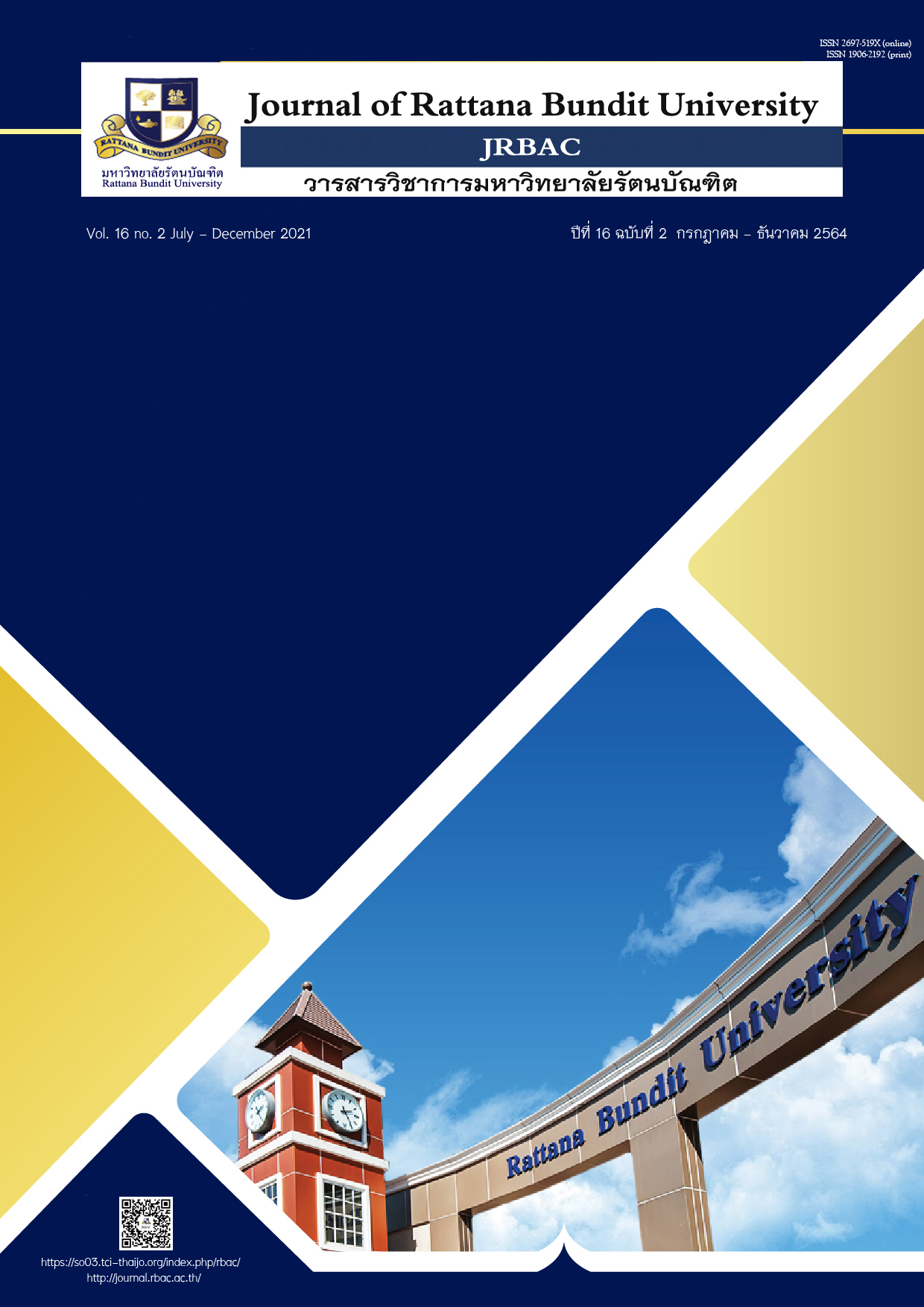Making impersonal comments via it-extraposition: Perspectives of syntactic structure, semantic denotations and pragmatic aspects via literature, magazines and applied linguistics articles in English
Main Article Content
Abstract
This study examined it- extraposition with adjectives followed by to-infinitive clauses (i.e., it is important to note that this research paper excludes that-clauses) via the perspectives of syntactic structure, semantic denotations, and pragmatic aspects. While most previous studies have focused on using it- extraposition in selected academic articles, the current study contributes to the views of English literature, magazines and applied linguistics articles. The entire 450,000 words contain 34 extracted tokens in the three datasets. This study shows that the use of it- extraposition occurs mostly in applied English linguistics articles at 64.71 percent. The use of it- extraposition in English magazines and literature is 23.53 percent and 11.76 percent, respectively. Extended projection principle could explain the lower use of it- extraposition in this study via the expletive. The semantic denotations between the three datasets appear to be different. The three datasets show similarities in that they apply the pragmatic aspects of the end-weight principle. It is hoped that this research will be useful for those learners of English as a second language and learners of English as a foreign language in making impersonal comments in different text varieties.
Article Details
References
Aronsson, M. B. (1999). The use of extraposition in writing produced by Swedish advanced learners of English. Paper from the ASLA Symposium Corpora in Research and Teaching, Vaxjo University, Sweden.
Caroll, L. (2015). The Annotated Alice. Martin Gardner, (Ed.). New York: W.W. Norton & Company.
Diezmas, E. N. (2019). Students, teachers and management teams in bilingual programmes: Shared perceptions and areas for improvement. Journal of English Studies, 17, 297-279.
Filmore, C. (1982). Frame semantics. In D. Geeraerts (Eds.). In Cognitive Linguistics: Basic Reading. (pp. 3-36). New York: Mouton de Gruyter.
Fumero-Perez, M., & Diaz-Galam, A. (2019). Designing the lexical rule for the parsing of ASD-STE100 Function words in ARTEMIS from a role and reference grammar perspective. Journal of English Studies, 17, 149-174
Hewings, A., & Hewings, M. (2015). Impersonalizing stance: A study of anticipatory ‘it’ in student and published academic writing. In C., Caroline, H., Ann &, O., Kieran (Eds.), Appling English
grammar: Functional and corpus approaches (pp. 101-116). London, UK: Hoddder Arnold.
Hussein, T. M. F. (2015). Discourse study of a clausal subject extraposition in selected political and religious speech. Journal of the College of Basic Education, 21, 25-44.
Jiménez-Fernández, A. (2020). Information-structure strategies in English and Spanish translation. Journal of English Studies, 18, 83-107.
Kalaba, J. (2021). Aestheticism and art nouveau in Oscar Wild’s Salome. British and American Studies, XXVII, 9-18.
Kaltenböck, G. (1999). Which it is it? Some remarks on anticipatory it. Vienna English Workings Papers, 8(2), 48-72.
Krapranov, O. (2021). Self-mention in research sections of university websites in Estonia and the United Kingdom. British and American Studies, XXVII, 57-69.
Larsson, T., & Kaatari, H. (2019). Extraposition in learners and expert writing. International Journal of Learner Corpus Research, 5(1), 33-62.
Lazaro, A. (2021). The culture of migration in British in modernist fiction. British and American Studies, XXVII, 9-18.
Magee, J. (2020). Power and social distance. Current Opinion in Psychology, 33, 33-37.
Mandaza, R. M. (2020), Semantic primes in historical langauges. The identification of the Old English exponent for DO. Journal of English Studies, 18, 125-151
Mestari, S. A., & Malabar, F. (2016). The use of authentic material in teaching grammar for EFL student. LLT Journal: A Journal on Language on Language and Language Teaching, 19(2), 125-131.
Moghaddam, R., & Ebrahimi, S. F. (2019). Subject it-extraposition in applied linguistics research articles: Semantic and syntactic analysis. Discourse and Interaction, 12(1), 29-46.
Morelius, A. (2018). The use of adjective in contemporary magazines: A gender- based study (Master Thesis). University of Gävle, Sweden.
Muliani, S., Norahmi, M., & Asi, N. (2019). The analysis of difficulties in writing narrative text. LET: Linguistics, Literature, English Teaching Journal, 9(2). 244-264.
Myskow, G., & Underwood, P. (2020). Applying concepts in international relations: The language of causal explanation in high and low graded concept application essays. English for Specific Purposes, 60, 113-126.
Radford, A. (2009). An introduction to English sentence structure. Cambridge: Cambridge University Press.
Rachmawati, F. (2017). The use of fairytale files in teaching narrative writing. Journal of English and Education, 5(1), 20-26.
Samraj, B. (2021). Variation in interpersonal relations in manuscript reviews with different recommendations. English for Specific Purposes, 62, 70-83.
Smolka, V. (2005). Non-extraposed subject clauses. In Proceeding from the Eight Conference of British, American and Canadian studies. Masarykova University. Czech Republic
Stosi, D. (2021). Persuasion strategies for demonstrating topic significance in reports of randomised controlled trials. English for Specific Purposes, 62, 1-14.
Traver, P. (2020). New ways of looking into hand written miscellanies of the seventeenth century: The case of “Spes Altera”. Journal of English Studies, 18, 205-225.
van Linden, A. (2010). The rise of the to-infinitive: evidence from adjectival complementation. English Language and Linguistics, 14(1), 19-51.
Wilinski, J. (2018). Adjective in extraposed constructions with that- clauses: A qualitative corpus-driven analysis. Brno Studies in English, 44(1), 83-102.
Wilinski, J. (2019). Co-varying verbs and adjective of it-extraposed constructions with to infinitive clauses in academic discourse: a qualitative corpus-driven study. Linguistica Pragensia, 29(1), 7-28
Writer, S. (2018). The bedtime story: A new chapter. Indian Journal of Health and Well Being.
Wongkittiporn, A. (2021). Semantic denotations and pragmatic aspects of that- clauses complements in English bedtime stories. Academic Journal of Humanity and Social Sciences Burapha University, 29(2), 217-242.
Zhang, G. (2015). It is suggested that or it is better to…? Forms and meanings of subject it extraposition in academic and popular writing. Journal of English for Academic Purposes, 20, 1-13.
Yin, Z., & Parkinson, J. (2021). Critical review of literature: The case of the news and views genre. English for Specific Purposes, 51, 1-14.


